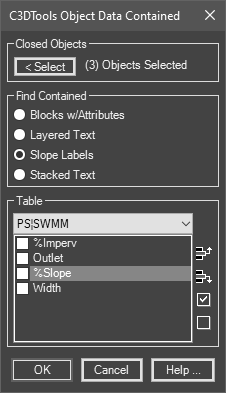Used to quickly set entity data values of linear closed objects to values of nodal objects contained within them. There are multiple methods available, each is explained in detail below.
Keyboard Command: EntDatCon

- Blocks w/Attributes: Expects a single block insert to be inside the closed object. This insert needs attributes with tag names that correspond to the entity data fields defined. Attribute tags not found in the entity data table will be ignored.
- Layered Text: Expects any number of text/mtext objects to be inside the closed object in any order or position. However these annotations must reside in a layer having the name of the object data fields. In other words if an annotation is inside the object and is on layer PARCELID, its text value will be placed in the PARCELID object data field of the boundary.
- Slope Labels: Collects the slope values from all slope labels contained within and averages the values, placing the average value in the highlighted field. If all slope arrows are 2 point arrows, the tool will apply a weighted average using the distance between the two points as the weighting factor.
Important: This tool uses CAD engine selection to find all labels inside the boundaries. Make sure the entire boundaries are shown inside the viewport before beginning this tool. If you are zoomed in on a boundary it will not find all the labels!
- Stacked Text: Expects any number of text/mtext objects to be inside the closed object in a top down order. You then tell the application what object data field each item belongs in.
Using the checkbox list at the bottom, turn on the checkmarks for fields it can expect to find. You can use the icons at right to move fields up and down in the list. In the dialog example above, it expects three pieces of text/mtext stacked on top of each other, the first being the PARCELID, then OWNSUR, etc.
General Procedure:
- Open the drawing containing the objects.
- Initiate this tool.
- Choose the button and choose the linear closed objects.
- Choose the desired method from the list of options.
- Choose the Entity Data table to use.
- Choose additional settings depending on the method.
- Choose the button to acquire the data.
Notes:
- If the bounding objects do not have entity data records, they will be added by this process. If they have existing records the appropriate fields will be populated.
- If using the stacked method and one (or more) collections contain a missing row, move the valid text down and place a "?" text object in the stack to maintain proper positions.
 Entity Data Acquire Contained
Entity Data Acquire Contained